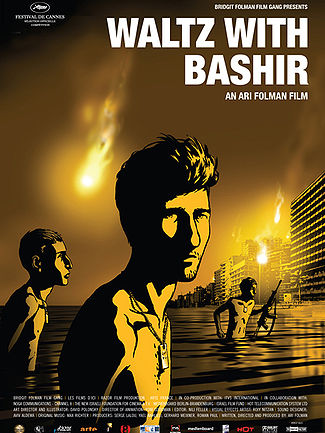The CRASSH Research Group Power and Vision: The Camera as Political Technology reports on their second session.

For the second event of the term, Power and Vision held a film screening of Waltz with Bashir, an Ari Folman film, followed by a guided discussion. The film traces Folman’s search for his lost memories as an Israeli soldier in the 1982 Lebanon War, deploying a variety of visual technologies that include photographs, drawn images in graphic novel form, and real footage. By emphasizing how perception, vision, memory and history can be retrospectively constructed, Waltz with Bashir poses key questions about the capacity for such technologies to verify facts or to reveal their fictionality.
The screening triggered a variety of emotions for many attendees, with reactions ranging from anger, disgust, and confusion to regret, remorse, and sadness. These emotions carried over into the guided discussion, where individuals engaged in constructive debate, allowing everyone in the room to hear differing opinions and finally construct their own. One source of deliberation was the way in which people categorize the film; is it a documentary, (anti) war film, animated film, or something in between? Although it is often considered to be a documentary, many people understand a documentary as being a truthful, or factual, account of something, and for many of the attendees, much of Waltz with Bashir felt like a search for the truth, rather than the truth itself. The film’s format, particularly its use of animation, further complicates this point, as it calls into question the value we give to varying forms of visual representation, including animation, oral testimony, and real footage.
Another critical point of discussion was the role within the film’s narrative of the Palestinians who were killed in the Sabra and Shatila refugee camps’ massacres. This has been a point of debate since its release, and many attendees viewed the apparent lack of engagement with the Palestinian population as problematic and evasive. They shared that a proper understanding of these events can only be attained through viewing them from a myriad of perspectives, including those of the victims. Several attendees, however, did not believe that it would have been appropriate for Folman to portray the Palestinian narrative, as this would have perpetuated the uneven distribution of power between the groups of people involved. Instead, they suggested that the film may have provided a more accurate depiction had it been part of a series of animated films, one of which could have been produced by a Palestinian filmmaker to appropriately illustrate the Palestinian experience during the 1982 Lebanon War.
Ultimately, attendees engaged deeply with the film’s themes, as well as with each other, and this allowed for an insightful experience for all those who came. Although Waltz with Bashir touched upon several challenging topics that elicited a range of emotions, experiences, and opinions, the guided discussion allowed for individuals to freely express their views, concerns, praise, and condemnation, further emphasizing the idea that there are always multiple sides to every story.
• Contributors: Jessica Fernández de Lara Harada and Katherine Mato

